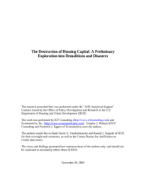
An official website of the United States government
Here’s how you know
Official websites use .gov
A .gov website belongs to an official government organization in the United States.
Secure .gov websites use HTTPS
A lock (
) or https:// means you’ve safely connected to the .gov website. Share sensitive information only on official, secure websites.
-
//
- Census.gov /
- Research /
- Technical Survey Research /
- The Destruction of Housing Capital: A Preliminary Exploration into Demolitions and Disasters
The Destruction of Housing Capital: A Preliminary Exploration into Demolitions and Disasters
The Destruction of Housing Capital: A Preliminary Exploration into Demolitions and Disasters
Although extensive data systems exist that follow additions to the housing stock, the process through which housing units leave the stock is not as well documented. The American Housing Survey (AHS) is one of the few data sources that explicitly track housing unit losses. The AHS has features that make it well suited to an analysis of housing loss, particularly its large sample size, extensive information on the physical characteristics of housing units, good neighborhood data, and the ability to track the same unit over time. However, researchers must first deal with a number of conceptual and data problems. The first goal of this paper, then, is to examine how to use the AHS to study these problems. The second goal is to use the AHS to analyze, in a preliminary fashion, what units are destroyed and why. We start by assuming that disaster losses are random. For this reason, we analyze demolitions separately from disasters. We explain demolition losses in terms of two different phenomena– loss of economic value and land alone becoming more valuable than land plus existing structure. Using data from the 1985–2001 AHS waves, we develop a model to explain the log-likelihood of losses in terms of characteristics variables, path variables, and cause variables. The most consistently useful variables in predicting housing unit losses are the “path” set, including renter occupancy, vacancy, inadequate quality, temporary loss (type B status), and low unit rating by residents.
Share
Some content on this site is available in several different electronic formats. Some of the files may require a plug-in or additional software to view.
 Yes
Yes
 No
NoComments or suggestions?


Top


